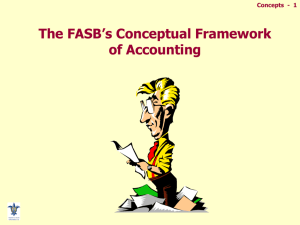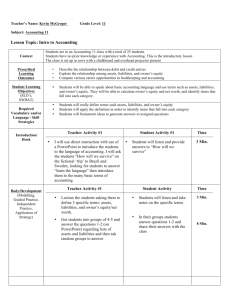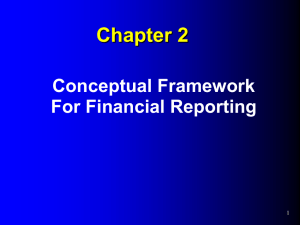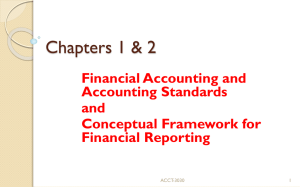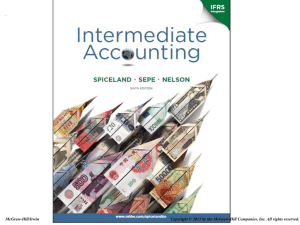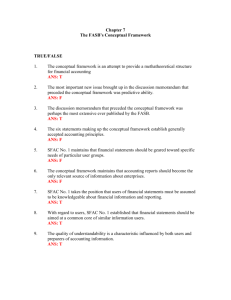Chapter 2: Conceptual Framework Underlying Financial
advertisement
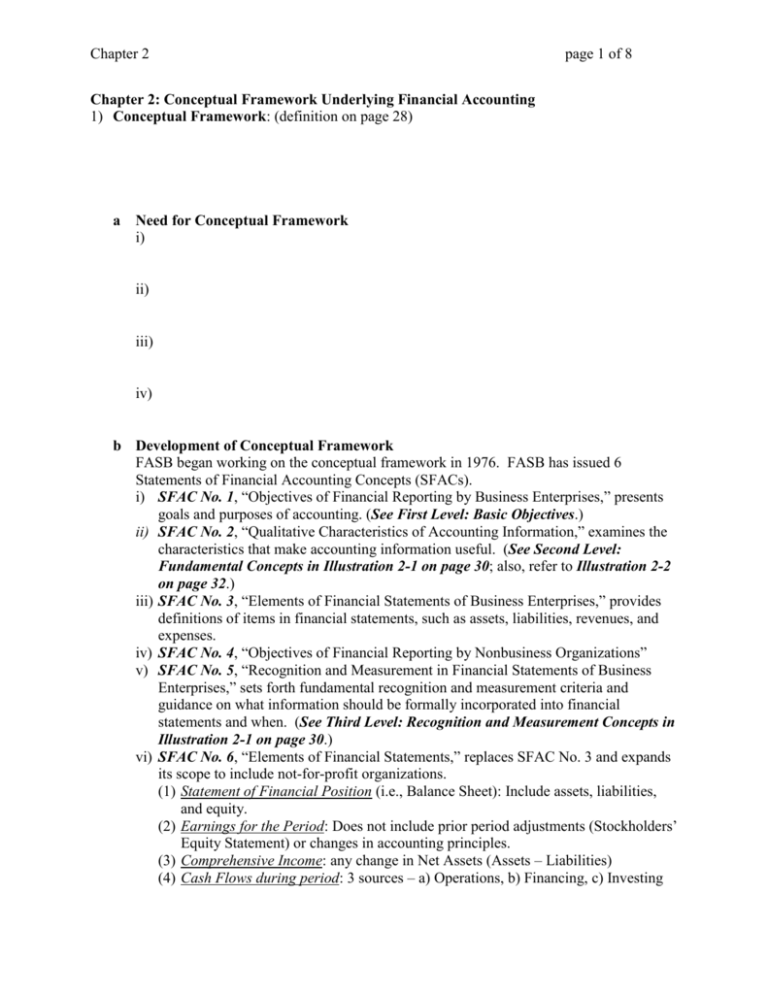
Chapter 2 page 1 of 8 Chapter 2: Conceptual Framework Underlying Financial Accounting 1) Conceptual Framework: (definition on page 28) a Need for Conceptual Framework i) ii) iii) iv) b Development of Conceptual Framework FASB began working on the conceptual framework in 1976. FASB has issued 6 Statements of Financial Accounting Concepts (SFACs). i) SFAC No. 1, “Objectives of Financial Reporting by Business Enterprises,” presents goals and purposes of accounting. (See First Level: Basic Objectives.) ii) SFAC No. 2, “Qualitative Characteristics of Accounting Information,” examines the characteristics that make accounting information useful. (See Second Level: Fundamental Concepts in Illustration 2-1 on page 30; also, refer to Illustration 2-2 on page 32.) iii) SFAC No. 3, “Elements of Financial Statements of Business Enterprises,” provides definitions of items in financial statements, such as assets, liabilities, revenues, and expenses. iv) SFAC No. 4, “Objectives of Financial Reporting by Nonbusiness Organizations” v) SFAC No. 5, “Recognition and Measurement in Financial Statements of Business Enterprises,” sets forth fundamental recognition and measurement criteria and guidance on what information should be formally incorporated into financial statements and when. (See Third Level: Recognition and Measurement Concepts in Illustration 2-1 on page 30.) vi) SFAC No. 6, “Elements of Financial Statements,” replaces SFAC No. 3 and expands its scope to include not-for-profit organizations. (1) Statement of Financial Position (i.e., Balance Sheet): Include assets, liabilities, and equity. (2) Earnings for the Period: Does not include prior period adjustments (Stockholders’ Equity Statement) or changes in accounting principles. (3) Comprehensive Income: any change in Net Assets (Assets – Liabilities) (4) Cash Flows during period: 3 sources – a) Operations, b) Financing, c) Investing Chapter 2 page 2 of 8 (5) Investments and Distributions to Owners: Statement of Stockholders’ Equity: Beginning Capital + Investment + Earnings – Dividends = Ending Capital vii) SFAC No. 7, “Using Cash Flow Information and Present Value in Accounting Measurements,” provides a framework for using expected future cash flows and present values as a basis for measurement. Note: See Illustration 2-1 on page 30. Homework: Q2, E1, 2, 3 2) First Level: Basic Objectives (SFAC No. 1): Identify the goals and purposes of accounting. Objectives provide information: a b c Decision usefulness is key to the conceptual framework. General-purpose financial statements provide the most useful information possible at minimal cost to users. Of course, users need to have a reasonable knowledge of business and financial accounting measures to understand financial statements. 3) Second Level: Fundamental Concepts (SFAC No. 2): (See Illustration 2-2, p32.) a Qualitative Characteristics of Accounting Information: make accounting information useful. (Need to determine which alternative provides the most useful information for decision-making purposes – decision usefulness.) i) Decision Makers (Users) and Understandability: Information should be of such quality that it is understandable to users. (1) Understandability: (2) Decision Usefulness: Two Dimensions of Usefulness: relevance and reliability. The qualities that distinguish ‘better’ (more useful) information from ‘inferior’ (less useful) information are primarily the qualities of relevance and reliability, with some other characteristics that those qualities imply. ii) Primary Qualities: Relevance and Reliability: (1) Relevance. Chapter 2 page 3 of 8 Relevant info has: (a) Predictive value: (b) Feedback value: (c) Timeliness: (2) Reliability: Reliable information has: (a) Verifiability: (b) Representational faithfulness: (c) Neutrality: iii) Secondary Qualities: Comparability and Consistency: (1) Comparability: Accounting information that has been measured and reported in a similar manner for different enterprises is considered comparable. (2) Consistency: Accounting information is consistent when an entity applies the same accounting treatment from period to period to similar accountable events. Homework: Q3, 4, 6 b Basic Elements (e.g., assets, liabilities, etc.): FASB considers these ten elements to be most closely related to financial measurement of an enterprise. Defined in Concepts Stmt No. 6: The first group of three elements (assets, liabilities, and equity) describes amounts of resources and claims to resources at a moment in time. The other seven elements describe transactions, events, and circumstances that affect an enterprise during a period of time. Chapter 2 page 4 of 8 Following List is included on page 35. i) Assets: Probable future economic benefits obtained or controlled by a particular entity as a result of past transactions or events. ii) Liabilities: Probable future sacrifices of economic benefits arising from present obligations of a particular entity to transfer assets or provide services to other entities in the future as a result of past transactions or events. iii) Equity: Residual interest in the assets of an entity that remains after deducting its liabilities. In a business enterprise, the equity is the ownership interest. iv) Investments by Owners: Increases in net assets of a particular enterprise resulting from transfers to it from other entities of something of value to obtain or increase ownership interests (or equity) in it. Owners most commonly receive assets as investments, but that which is received may also include services or satisfaction or conversion of liabilities of the enterprise. v) Distributions to Owners: Decreases in net assets of a particular enterprise resulting from transferring assets, rendering services, or incurring liabilities by the enterprise to owners. Distributions to owners decrease ownership interests (or equity) in an enterprise. vi) Comprehensive Income: Change in equity (net assets) of an entity during a period from transactions and other events and circumstances from nonowner sources. It includes all changes in equity during a period except those resulting from investments by owners and distributions to owners. vii) Revenues: Inflows or other enhancements of assets of an entity or settlement of its liabilities (or a combination of both) during a period from delivering or producing goods, rendering services, or other activities that constitute the entity’s ongoing major or central operations. viii) Gains: Increases in equity (net assets) from peripheral or incidental transactions of an entity during a period except those that result from revenues or investments by owners. ix) Losses: Decreases in equity (net assets) from peripheral or incidental transactions of an entity and from all other transactions and other events and circumstances affecting the entity during a period except those that result from expenses or distributions to owners. 4) Third Level: Recognition and Measurement Concepts: used in establishing and applying accounting standards (i.e., concepts that implement the basic objectives of level one.) Consists of concepts which explain how financial elements and events should be recognized, measured, and reported by the accounting system. Focus on understanding the concepts not on classification (i.e., assumptions, principles, constraints) a Basic Assumptions: i) Economic Entity Assumption: Chapter 2 page 5 of 8 ii) Going Concern Assumption: This approach is used in financial statements as opposed to a liquidation approach. iii) Monetary Unit Assumption: Record in terms of dollars. The monetary unit is relevant, simple, universally available, understandable, and useful. A second assumption (often called the Stable Dollar concept) is that the monetary unit remains reasonably stable (i.e., every $1 is of equal worth.) iv) Periodicity Assumption: Investors are demanding more rapid information. Thus, financial statement users must consider the trade-off between relevance and reliability. b Basic Principles of Accounting: Four basic principles to record transactions. i) Historical Cost Principle: ii) Revenue Recognition Principle: Revenue is recognized (i.e., recorded in the financial statements) when the earnings process is virtually complete and an exchange transaction has occurred. In other words, revenue is generally recognized (1) when realized or realizable and (2) when earned. Realized: Realizable: Earned: Chapter 2 page 6 of 8 Recognition at the time of sale provides a uniform and reasonable test. Generally, if a sale has been completed, it should be recognized; if bad debts are expected, they should be recorded as separate estimates. Exceptions to the revenue recognition principle include: (1) During Production (or Percentage of Completion Method): Revenue is allowed before the contract is completed in certain long-term construction contracts. The earnings process is considered substantially completed at various stages as construction progresses, even though ownership has not been transferred. Must have good estimates to be able to use this method. (2) At End of Production: Revenue might be recognized after the production cycle has ended but before the sale takes place. For example, revenue may be recognized for commodities (e.g., agricultural products) and precious metals (e.g., gold) upon completion because of established markets and prices. (3) Upon Receipt of Cash: Recognize revenue when cash is received. One form is the Installment Sales Method. Here, payment is required in periodic installments over a long period time (e.g., retail, farm/home equipment.) Revenue is recognized as each cash installment is received. This is justified because the risk of not collecting is high. iii) Matching Principle: This assumes cause/effect relationship (gives users more usable information in determining future cash flow.) A major concern is that matching permits certain costs to be deferred and treated as assets on the balance sheet when in fact these costs may not have future benefits (e.g., improvements to assets.) Relates to how we measure earnings: (1) Direct Matching (cause and effect): (2) Indirect Matching: (a) Systematic and rational allocation: (b) Period Costs: Chapter 2 page 7 of 8 Matching Process Summarized: First, see if direct relationship exists between cost and revenue. If so, use direct matching. If not, determine if a systematic and rational allocation method be used. If so, use the method. If not, immediately expense. iv) Full Disclosure Principle: Recognizes that nature and amount of information in financial reports reflects a series of judgmental trade-offs. Certain footnotes (FN) are required. FN explain items presented within financial statements. FN do not have to be quantifiable or an element. Supplementary information (such as oil and gas reserve info) is provided. Information should be understandable to a reasonably prudent investor. Items should meet four fundamental recognition criteria to be recognized in the financial statements: (1) Definitions: (2) Measurability: (3) Relevance: (4) Reliability: Homework: Q10, 14, 16, 20, 21; E 6 c Constraints: i) Cost-Benefit Relationship: Frequently it is easier to assess the costs than it is to determine the benefits of providing a particular item of information. ii) Materiality: The magnitude of an omission or misstatement of accounting information that, in light of surrounding circumstances, makes it probable that the judgment of a reasonable person relying on the information would have been changed or influenced by the omission or misstatement. Chapter 2 page 8 of 8 (1) The concept of materiality is an EXTREMELY difficult concept. Materiality varies both with relative amount and with relative importance. (See Illustration 25.) (2) Companies and their auditors for the most part have adopted the general rule of thumb that anything under 5 percent of net income is considered immaterial. However, both quantitative and qualitative factors must be considered in determining whether an item is material. (3) The SEC had indicated that companies must consider each misstatement separately and the aggregate effect of all misstatements. iii) Industry Practices: Peculiar nature of industry or business may result in variation (e.g., utility industry lists non-current assets first b/c of capital intensive nature of industry; agricultural industry lists crops at market value b/c difficult to quantify cost of individual crops.) iv) Conservatism: d Summary of the Structure: See Illustration 2-6. Homework: E 4, 5



